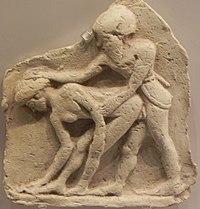
Photo from wikipedia
A clear stele image of ancient Chinese calligraphy pieces is very useful for studying ancient Chinese calligraphy. However, due to hundreds of or even thousands of years of natural or… Click to show full abstract
A clear stele image of ancient Chinese calligraphy pieces is very useful for studying ancient Chinese calligraphy. However, due to hundreds of or even thousands of years of natural or artificial damage on stele, images of ancient Chinese stele calligraphy works usually suffer from a large amount of image noise, and which usually leads to a poor visibility. To address this problem, in this paper, we propose a de-noising method based on L0 gradient minimization and guided filter. It consists of two main operations in sequence: First, L0 gradient minimization is utilized to obtain a random-noise free map, and then the random-noise free map is used as a guided image, and convoluted with its corresponding original noised stele image by a guided filter to obtain an edge preserved random-noise free image. Finally, the eight-connection region-based de-noising technique is followed to remove ant-like isolated blocks. Experiments demonstrate that the proposed method is superior to several recent published stele image de-noising techniques in terms of preserving the character structures.
Journal Title: EURASIP Journal on Image and Video Processing
Year Published: 2019
Link to full text (if available)
Share on Social Media: Sign Up to like & get
recommendations!